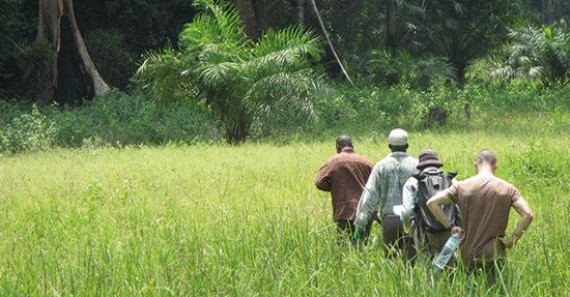
Above, Dr. Leendertz and his team during their field work in Guinea, where they believe the 2014 Ebola outbreak began after a two-year-old child was infected by a bat in the village of Meliandou.
Scientists have traced the beginning of the 2014 Ebola outbreak to a two-year-old boy named Emile Ouamouno, who lived in a small village called Meliandou in Guinea and died in Dec. 2013. However, exactly how the toddler contracted Ebola in the first place has remained a mystery.
Now, a small team of anthropologists, veterinarians and ecologists think they may have the answer. In a study published Tuesday in the journal EMBO Molecular Medicine, lead author Dr. Fabian Leendertz of the Robert Koch Institute in Germany hypothesizes that Ouamouno got Ebola from a hollowed out tree where children in his community would often play. That tree, it turned out, was home to a large colony of free-tailed bats, which have survived experimental Ebola infection in previous research. That particular species of bat has also been discussed as a potential source for the virus in past outbreaks.
Ebola is a zoonotic virus, which means that it can pass from animals to humans. In the past, Ebola outbreaks have been traced to bushmeat hunters killing and eating fresh meat from large primates. But Dr. Leendertz and his team ruled out that possibility for two reasons: one, usually the hunters themselves would be the first to come down with Ebola, and two, large primates are increasingly scarce and difficult to catch near Meliandou, according to villagers.
So instead, Dr. Leendertz turned his attention toward fruit bats, another known Ebola virus carrier. Yet this seemed an unlikely source of infection upon further investigation; the fruit bat colonies were relatively far away from Ouamouno’s village and besides, fruit bat hunters weren’t the first to get sick with Ebola, as they usually would be.
Finally, Dr. Leendertz focused on insectivorous bats, which children in the village regularly hunted and grilled. He noted a large, hollowed-out tree stump about 55 yards from Ouamouno’s home, along a well-trafficked path where women would walk on their way to a small river to do their washing. Villagers told Dr. Leendertz that children would often play in the hollowed-out tree, which turned out to be the home of a large colony of insectivorous bats.

A: The village of Meliandou. B–D: The burnt hollow tree; in (D), the arrow points at a stick, likely left there by children.
Dr. Leendertz described the tree stump:
When we arrived, the tree had been mostly burned and only the stump and fallen branches remained (Fig 3C and D). Villagers reported that it burned on March 24, 2014 and that once the tree caught fire, a “rain of bats” started and a large number of bats were collected for consumption (see Materials and Methods). The bats were described as lolibelo, that is, small, smelly bats with a long tail. We found no evidence of additional zoonotic transmission events stemming from the consumption of these bats, but villagers reported disposing of them after a ban on bushmeat consumption was announced the following day.
Children would often capture these bats and play with them, writes Dr. Leendertz, and the first cluster of Ebola cases in Meliandou were mostly children and women, he notes, but because he wasn’t able to test any of the bats that lived in the tree, there’s no way to know for sure if they did indeed transmit Ebola to the little boy.
For now, he says that his study is enough evidence to begin including insectivorous bats in Ebola outbreak analyses, where before scientists would point the finger at fruit bats or large primates. If Ouamouno is indeed the very first Ebola patient of this current outbreak, extra care needs to be taken to “avoid retribution attacks and stigmatization of the region,” Dr. Leendertz cautioned. He also wrote that while the public needs to be informed of the risks of handling bats, they also need education about the “crucial ecosystem services” bats provide, which include huge benefits to humans.
The death toll from the Ebola outbreak in West Africa has reached 7,905, out of a total 20,206 cases of the disease, according to the latest figures from the World Health Organization (WHO), marking the largest and most complex outbreak in history.
